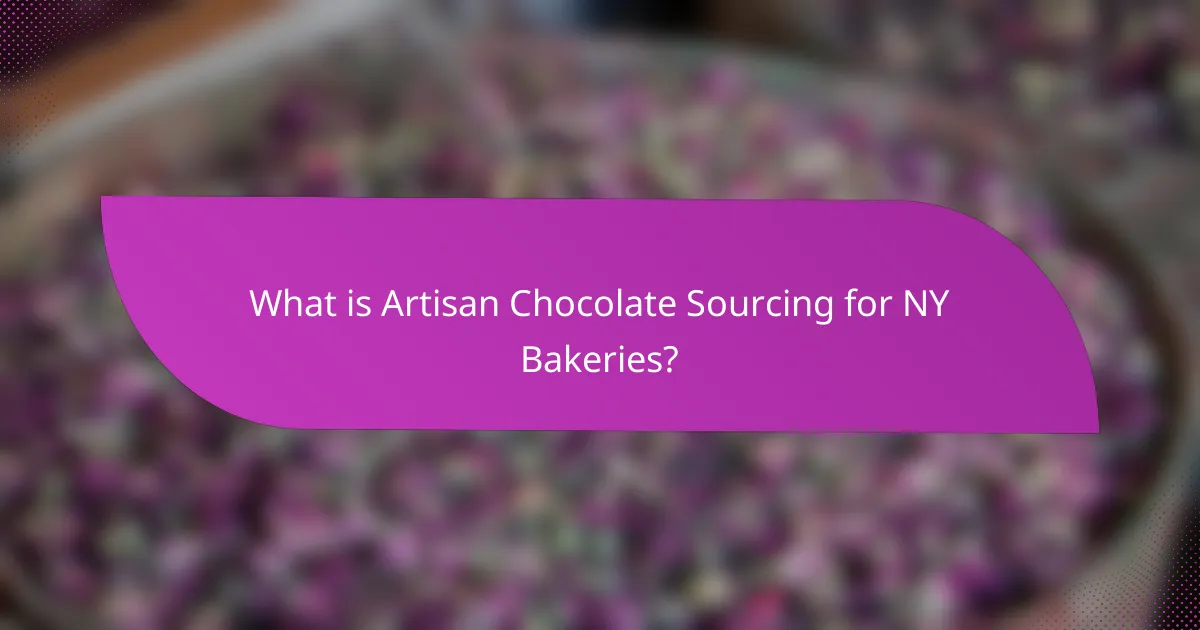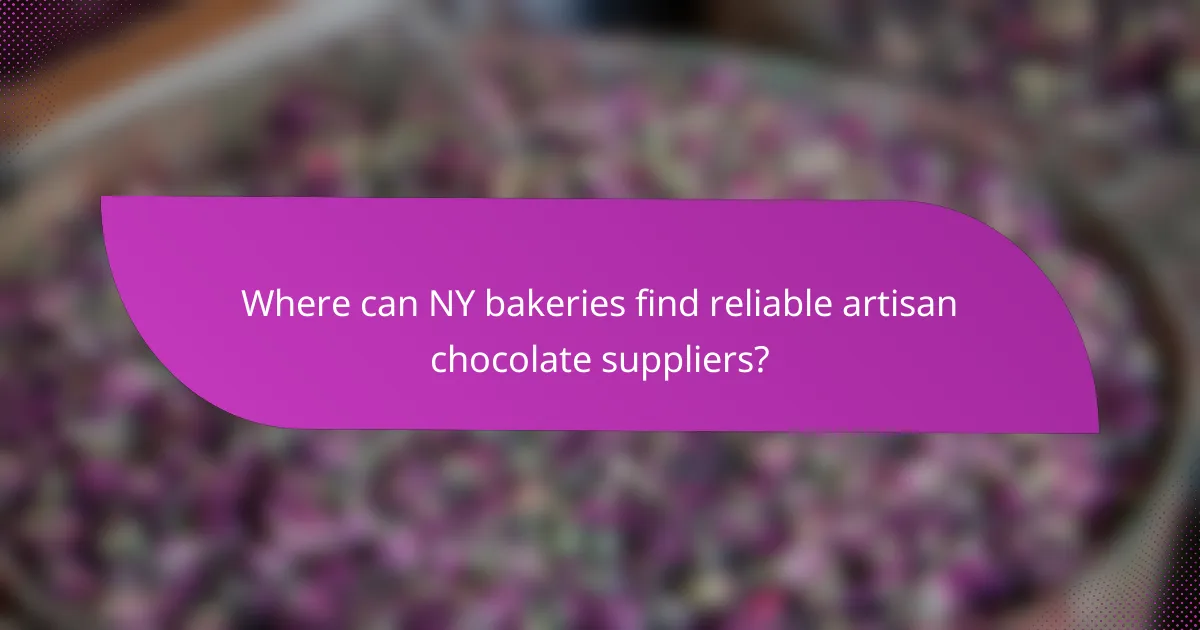Artisan chocolate sourcing for New York bakeries involves acquiring high-quality, handcrafted chocolate from specialized producers who prioritize ethical and sustainable practices. This process focuses on selecting premium cacao beans from specific regions, enhancing flavor profiles and supporting local economies. New York bakeries can establish direct relationships with reputable suppliers, including local chocolatiers and specialty distributors, while engaging in trade shows for networking opportunities. Reliable sources for artisan chocolate include Fine & Raw Chocolate, Raaka Chocolate, and online platforms like Chocolate Alchemy and Cacao Barry. This sourcing approach not only ensures consistent quality but also fosters a sustainable supply chain that benefits both bakers and artisans.

What is Artisan Chocolate Sourcing for NY Bakeries?
Artisan chocolate sourcing for NY bakeries refers to the practice of obtaining high-quality, handcrafted chocolate from specialized producers. This process emphasizes selecting chocolate made from premium cacao beans, often sourced from specific regions known for their unique flavor profiles. NY bakeries prioritize ethical sourcing practices, ensuring fair trade and sustainable farming methods are used. Many artisan chocolatiers focus on small-batch production, which enhances flavor and quality. This sourcing approach supports local economies and promotes environmental responsibility. Additionally, it allows bakers to create distinctive products that stand out in a competitive market.
How does artisan chocolate sourcing impact bakery offerings?
Artisan chocolate sourcing significantly enhances bakery offerings by providing unique flavor profiles. This type of chocolate often features high-quality ingredients and distinct regional characteristics. For instance, single-origin chocolates can impart specific taste notes based on their geographical source. Bakeries that utilize artisan chocolate can create more sophisticated and diverse products.
Additionally, sourcing from ethical producers can improve a bakery’s brand image. Consumers increasingly prefer products that support fair trade and sustainable practices. This alignment with ethical sourcing can attract a more conscious customer base. According to a 2021 survey by the National Confectioners Association, 78% of consumers are willing to pay more for ethically sourced chocolate. Overall, artisan chocolate sourcing positively influences both the flavor and ethical standing of bakery offerings.
What are the unique characteristics of artisan chocolate?
Artisan chocolate is distinguished by its high-quality ingredients and meticulous production methods. It typically uses premium cacao beans sourced from specific regions, enhancing flavor complexity. The chocolate is often crafted in small batches, allowing for greater attention to detail. Artisan producers prioritize traditional techniques, such as conching and tempering, which contribute to a smooth texture. Unique flavor profiles arise from the use of single-origin cacao, which reflects the terroir of its growing region. Additionally, artisan chocolate often features minimal additives, focusing on pure cocoa and natural sweeteners. This commitment to quality results in a more intense and nuanced taste experience compared to mass-produced chocolate.
How does sourcing influence flavor profiles in baked goods?
Sourcing significantly influences flavor profiles in baked goods by determining the quality and characteristics of the ingredients used. The origin of chocolate, for example, affects its flavor notes, such as fruity, nutty, or floral. Different regions produce cacao with distinct flavor profiles due to variations in soil, climate, and cultivation methods. For instance, cacao from Madagascar is known for its bright acidity and berry notes. In contrast, Ecuadorian cacao often has a more earthy and nutty flavor. The processing methods, including fermentation and drying, also play a crucial role in developing these flavors. High-quality, ethically sourced ingredients tend to enhance the overall taste and appeal of baked goods. Studies have shown that consumers prefer products made with premium ingredients, which can lead to higher sales and customer satisfaction.
What ethical practices are involved in artisan chocolate sourcing?
Ethical practices in artisan chocolate sourcing include fair trade, sustainable farming, and direct trade. Fair trade ensures that farmers receive a fair price for their cocoa. This practice supports community development and improves living conditions. Sustainable farming focuses on environmentally friendly methods. It reduces deforestation and promotes biodiversity. Direct trade involves establishing relationships between chocolatiers and farmers. This practice enhances transparency in the supply chain. These ethical practices contribute to better quality chocolate and support local economies. Research indicates that ethical sourcing can increase consumer trust and loyalty.
Why is sustainability important in chocolate sourcing?
Sustainability is crucial in chocolate sourcing to ensure environmental protection and social responsibility. Sustainable practices help preserve biodiversity and reduce deforestation associated with cocoa farming. For instance, according to the World Cocoa Foundation, sustainable cocoa farming can lead to a 20% increase in yield while minimizing ecological impact. Additionally, sustainability supports fair labor practices, ensuring that farmers receive fair wages and work in safe conditions. The Fair Trade certification, which many sustainable chocolate brands pursue, guarantees that farmers are compensated fairly, promoting community development. Thus, sustainability in chocolate sourcing not only protects the environment but also fosters equitable economic growth for cocoa farmers.
How do fair trade practices affect chocolate suppliers?
Fair trade practices positively affect chocolate suppliers by ensuring fair wages and sustainable farming conditions. Suppliers receive a guaranteed minimum price for their cocoa, which protects them from volatile market fluctuations. This stability allows for better financial planning and investment in their farms. Fair trade also promotes environmentally sustainable practices, encouraging suppliers to use organic methods. Additionally, suppliers gain access to international markets through fair trade certifications. This can increase their customer base and sales. Evidence shows that fair trade cocoa farmers earn up to 30% more than conventional farmers. Overall, fair trade practices enhance the livelihoods of chocolate suppliers while promoting ethical consumption.
What are the flavor profiles associated with artisan chocolate?
Artisan chocolate features complex flavor profiles that can include fruity, nutty, floral, and spicy notes. The specific flavors depend on the cacao beans’ origin, processing methods, and added ingredients. For instance, chocolate from Madagascar often has bright citrus and berry flavors. In contrast, beans from Ecuador may exhibit nutty and earthy undertones. The fermentation process also influences flavor development. High-quality artisan chocolate typically showcases a balance of sweetness and bitterness. Additionally, the roasting level can enhance or mute certain flavor characteristics. These profiles are often analyzed through tasting notes provided by chocolatiers, which highlight the unique attributes of each batch.
How do different cacao varieties influence flavor?
Different cacao varieties significantly influence flavor. The primary cacao varieties are Criollo, Forastero, and Trinitario. Criollo beans are known for their complex flavors and lower bitterness. They often exhibit fruity and floral notes. Forastero beans are more robust and have a stronger, more bitter taste. This variety is commonly used in mass-produced chocolate. Trinitario beans are a hybrid of Criollo and Forastero. They combine the best attributes of both, offering a balance of flavor complexity and robustness. The growing conditions and fermentation processes also affect flavor profiles. For instance, cacao grown in different regions can have distinct tastes due to soil and climate variations.
What role do processing methods play in flavor development?
Processing methods significantly influence flavor development in chocolate. Techniques such as fermentation, roasting, and conching alter the chemical composition of cocoa beans. Fermentation develops precursors for flavor compounds, enhancing complexity. Roasting brings out desired flavors while reducing bitterness. Conching smooths texture and further refines flavor. Each method contributes uniquely to the final taste profile. Studies show that different roasting temperatures can enhance specific flavor notes. For instance, lower temperatures preserve fruity notes, while higher temperatures emphasize nutty flavors. These processing methods are crucial for creating distinct and appealing chocolate flavors.

How can NY bakeries effectively source artisan chocolate?
NY bakeries can effectively source artisan chocolate by establishing direct relationships with reputable suppliers. They should prioritize sourcing from local chocolatiers and specialty distributors. Engaging in trade shows and chocolate festivals can provide valuable networking opportunities. Researching suppliers who focus on ethical sourcing practices enhances quality and sustainability. Additionally, bakeries can join industry associations for access to vetted suppliers. Leveraging online platforms that connect bakers with artisan producers can streamline the sourcing process. Consistent quality checks and tasting sessions ensure the chocolate meets their standards. These methods foster a reliable supply chain while supporting local artisans.
What are the key factors to consider in selecting chocolate suppliers?
Key factors to consider in selecting chocolate suppliers include quality, sustainability, and reliability. Quality refers to the flavor, texture, and overall characteristics of the chocolate. High-quality chocolate can enhance the final product’s taste and appeal. Sustainability involves sourcing practices that support ethical farming and fair trade. This ensures that suppliers adhere to environmentally friendly methods and fair labor practices. Reliability is crucial for consistent supply and timely delivery. A dependable supplier can help maintain production schedules and meet customer demands. Additionally, transparency in sourcing and production processes can foster trust between bakeries and suppliers.
How do location and accessibility impact supplier selection?
Location and accessibility significantly impact supplier selection by influencing logistics and costs. Suppliers located closer to bakeries reduce transportation time and expenses. This proximity can enhance freshness of ingredients, crucial for artisan chocolate. Accessibility also affects the reliability of supply. Suppliers with easier access facilitate more consistent deliveries. Additionally, local suppliers may align better with ethical sourcing practices. This alignment can appeal to consumer preferences in New York’s market. Hence, both location and accessibility are critical factors in selecting suppliers for artisan chocolate.
What certifications should bakeries look for in suppliers?
Bakeries should look for certifications such as Fair Trade, Organic, and Non-GMO Project Verified in suppliers. Fair Trade certification ensures ethical sourcing practices and fair wages for farmers. Organic certification guarantees that ingredients are grown without synthetic pesticides or fertilizers. Non-GMO Project Verified indicates that products do not contain genetically modified organisms. These certifications support sustainable practices and enhance product quality. They also align with consumer demand for transparency and ethical sourcing in food products.
What are the benefits of sourcing locally for NY bakeries?
Sourcing locally for NY bakeries enhances freshness and quality. Local ingredients often have a shorter time from farm to table. This results in superior flavor and texture in baked goods. Supporting local farmers boosts the regional economy. It fosters community relationships and encourages sustainable practices. Local sourcing reduces transportation emissions, benefiting the environment. Additionally, it allows bakeries to create unique, seasonal offerings. Research shows that consumers prefer products made with local ingredients, increasing customer loyalty.
How does local sourcing enhance freshness and flavor?
Local sourcing enhances freshness and flavor by reducing the time between harvest and consumption. When ingredients are sourced locally, they are often picked at peak ripeness. This ensures maximum flavor and nutritional value. Additionally, shorter transportation distances mean less time spent in storage. Studies show that produce loses flavor compounds over time. For example, fruits and vegetables can lose up to 50% of their flavor within a week of being harvested. Local sourcing also supports regional farmers, promoting sustainable agricultural practices. This results in higher quality ingredients that enhance the overall taste of artisan chocolate.
What community benefits arise from supporting local suppliers?
Supporting local suppliers fosters community benefits such as economic growth and job creation. Local suppliers keep money within the community, which stimulates local economies. This practice strengthens community ties by promoting local businesses. Additionally, it encourages sustainable practices and reduces carbon footprints through shorter transportation distances. Supporting local suppliers often leads to fresher products, enhancing consumer satisfaction. Studies show that local sourcing can increase community resilience during economic downturns. Local suppliers are more likely to invest in community initiatives, further benefiting residents. Overall, supporting local suppliers creates a vibrant, interconnected community.

Where can NY bakeries find reliable artisan chocolate suppliers?
New York bakeries can find reliable artisan chocolate suppliers through several established sources. Local suppliers like Fine & Raw Chocolate and Raaka Chocolate offer high-quality options. Additionally, online platforms such as Chocolate Alchemy and Cacao Barry provide a range of artisan chocolates. Trade shows like the New York Chocolate Show feature various suppliers. Networking with local chocolatiers can also lead to reliable recommendations. These sources are known for their commitment to quality and ethical sourcing practices.
What are the top regions known for quality artisan chocolate production?
The top regions known for quality artisan chocolate production include Belgium, Switzerland, and France. Belgium is renowned for its pralines and has a long history of chocolate craftsmanship. Swiss chocolate is famous for its smooth texture and high-quality ingredients. France is known for its innovative flavor combinations and artisanal techniques. Other notable regions include Ecuador, which produces fine flavor cacao, and Ghana, recognized for its high-quality cocoa beans. Each of these regions has established a reputation for excellence in chocolate making, contributing to the global artisan chocolate market.
How do different geographical locations affect chocolate quality?
Different geographical locations significantly affect chocolate quality. Factors such as climate, soil composition, and local farming practices influence the flavor and characteristics of cocoa beans. For instance, beans from Ecuador are known for their fruity notes due to the country’s unique climate and rich volcanic soil. In contrast, beans from Madagascar often have bright acidity and citrus flavors, attributed to the region’s specific growing conditions. Additionally, altitude plays a role; higher elevations can produce beans with more complex flavors. Research indicates that cocoa grown in diverse environments can yield distinct flavor profiles, enhancing the overall quality of chocolate products.
What are some recommended suppliers in the NY area?
Mast Brothers Chocolate and Fine & Raw Chocolate are recommended suppliers in the NY area. Mast Brothers specializes in artisanal chocolate bars made from ethically sourced beans. Fine & Raw focuses on organic, bean-to-bar chocolate with a commitment to sustainability. Both suppliers are well-regarded for their quality and flavor profiles. They have established reputations in the local baking community. Many NY bakeries source from these suppliers for premium chocolate products.
What trends are shaping the artisan chocolate market for bakeries?
Consumer demand for high-quality, ethically sourced ingredients is shaping the artisan chocolate market for bakeries. Bakeries are increasingly focusing on sustainability and transparency in sourcing. This trend reflects a growing awareness of environmental and social issues among consumers. Additionally, unique flavor profiles are gaining popularity, with a shift towards single-origin chocolates. Artisan chocolatiers are experimenting with local ingredients to create distinctive tastes. Health-conscious consumers are also driving demand for organic and sugar-free options. The rise of online sales channels is making artisan chocolate more accessible to bakeries. These trends highlight the evolving landscape of the artisan chocolate market.
How are consumer preferences influencing chocolate sourcing?
Consumer preferences are significantly influencing chocolate sourcing by prioritizing ethical and sustainable practices. Many consumers now demand transparency regarding the origins of their chocolate. This shift has led companies to source from fair trade and organic certified suppliers. Research indicates that 66% of consumers are willing to pay more for ethically sourced products. Additionally, flavor profiles are being tailored to meet preferences for unique and high-quality ingredients. This trend encourages sourcing from specific regions known for distinct chocolate characteristics. As a result, suppliers are adapting to meet these evolving consumer expectations.
What innovations are emerging in the artisan chocolate industry?
Emerging innovations in the artisan chocolate industry include bean-to-bar production techniques. These methods allow chocolatiers to control the entire process from sourcing to final product. Direct trade practices are gaining traction, ensuring fair compensation for farmers. Sustainable sourcing is becoming essential, with a focus on organic and ethically grown cacao. Flavor experimentation is on the rise, incorporating unique ingredients like spices and herbs. Advanced technology in processing is enhancing flavor extraction and consistency. Customization options for consumers are expanding, allowing personalized chocolate experiences. Finally, eco-friendly packaging solutions are being adopted to reduce environmental impact.
What tips can bakeries follow for successful artisan chocolate sourcing?
Bakeries can ensure successful artisan chocolate sourcing by prioritizing quality and ethical practices. They should seek suppliers that provide high-quality cocoa beans. Researching the origin of the chocolate is essential. This helps in understanding flavor profiles and sustainability practices. Establishing relationships with local chocolatiers can enhance sourcing efforts. Collaborating with suppliers who focus on fair trade practices is crucial. Bakeries should also consider seasonal availability of chocolate. This can influence both flavor and cost. Regularly tasting samples from different suppliers aids in making informed decisions.
How can bakeries build strong relationships with suppliers?
Bakeries can build strong relationships with suppliers by prioritizing clear communication. Regularly discussing expectations and needs fosters transparency. Timely payments reinforce trust and reliability in the partnership. Establishing long-term contracts can provide stability for both parties. Frequent visits to suppliers’ facilities can strengthen personal connections. Collaborative problem-solving during challenges enhances mutual respect. Sharing feedback on product quality promotes continuous improvement. Engaging in joint marketing initiatives can benefit both the bakery and the supplier. These practices lead to a more resilient and effective supply chain.
What best practices should be implemented for quality assurance?
Implementing best practices for quality assurance in artisan chocolate sourcing involves several key steps. Establishing clear quality standards is essential. These standards should define the desired characteristics of chocolate, such as flavor, texture, and appearance. Regular supplier audits ensure compliance with these standards. Audits can include assessments of sourcing methods and ingredient quality.
Training staff on quality control procedures is vital. Educated employees can better identify quality issues. Implementing a systematic testing process for chocolate batches helps maintain consistency. Testing can involve sensory evaluations and laboratory analysis.
Documenting quality assurance processes provides a reference for continuous improvement. Tracking results allows for identifying trends and addressing problems promptly. Collaborating with suppliers fosters transparency and accountability. Open communication can lead to improvements in sourcing practices.
These practices contribute to maintaining high-quality chocolate in NY bakeries. They ensure that products meet customer expectations and uphold ethical sourcing standards.
Artisan chocolate sourcing for NY bakeries involves obtaining high-quality, handcrafted chocolate from specialized producers who prioritize ethical practices and sustainability. This article explores the impact of artisan chocolate on bakery offerings, including unique flavor profiles derived from specific cacao origins and the importance of ethical sourcing to enhance brand image. It also examines the characteristics of artisan chocolate, the influence of sourcing on flavor development, and the benefits of local and sustainable supplier relationships. Additionally, the article highlights key factors for selecting suppliers, emerging trends in the artisan chocolate market, and best practices for quality assurance in sourcing.




